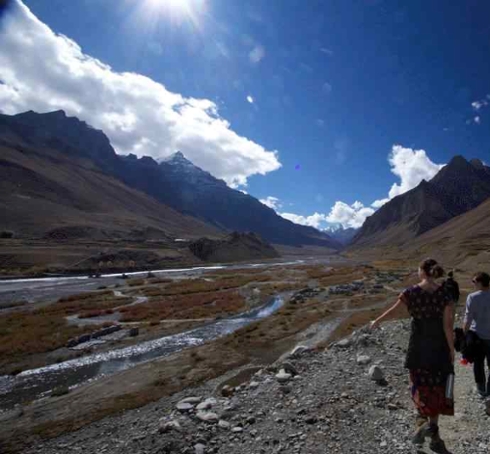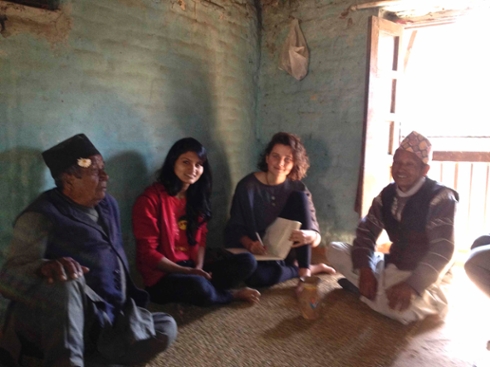Vishnus Discus: Briana Foley Researches with Newa Potters of Nepal

Briana Foley, a junior religion major, chased her newly kindled passion for ceramics to the edges of the earth. She spent four months abroad through the Tibetan and Himalayan Peoples SIT program. She concluded her trip by pursuing independent research in the settlement of Old Thimi in Kathmandu Valley. The indigenous settlement is home to the Newa people, an integral part of whose culture and lifestyle is ceramics.
Briana “became obsessed” with ceramics after taking an intensive course at Lewis and Clark. She also knew she was interested in traveling to South Asia after taking classes on Hinduism with Mari Jyavasjarvi, a visiting religion professor. These were her loves, and through the SIT program she was able to find a way to synthesize the two and create an original, exhilarating, and rewarding experience for herself.
She glows when she speaks of her time in Old Thimi. Her smile is radiant as she describes living with the community of potters, and the way she came to love the noise and chaos and the rawness of land and the people. Her eyes are alight with memories and every word about her experience and what she learned is bursting with unveiled excitement.
“Old Thimi is a craftsman community, and as in many craftsman communities, no one signs their work. Because for them pottery is about mass production, the pots are all virtually identical. I asked this impressive 94-year-old guy in better shape than me, ‘did you ever come up with own design? How can you tell your pot apart from the others?’ Because they load them all up on the same van for transport, but when they get to Kathmandu they each recognize their own pots! What this man told me was, ‘it’s like knowing your own handwriting. Of course I would recognize my own handwriting.’ The potters there have a completely different relationship to the clay than I did. They’ve been doing it since they were little. For me its art, but for them it’s work. It’s their trade.”
She tells me about the religious, historic, economic, and social dynamics that interact to create ceramics’ unique identity and role in Old Thimi and Nepal.
“Pottery in Nepal is totally on the outs. It’s caught up in the caste system,” she explains. The potter’s caste is indicated by the name “Prajapati.” The caste is considered low due to its close work with the earth. In addition, clay is more difficult to obtain than ever before, as potters must compete for resources with brick makers who seek the clay more and more as Kathmandu’s population burgeons. On top of this, demand for clay creations is on the decline as alternative materials such as plastics become more accessible.
In spite of being a “low” tradecraft, ceramics have a strong traditional and spiritual place in Newali culture. Briana tells me of the many myths and legends surrounding pottery. There are even religious rituals in which pots are transformed into gods.
“The potter who makes the pots must be completely pure. He can’t have any tattoos or missing fingers or physical imperfections. He must cut his nails and be purified before he makes the pots because he is going to make something that will become a god.” Briana pauses to take a breath, “it’s so interesting to consider, in the making of ritual objects that become gods, what that means in implications for the potter.”
Briana is highly aware of the inexorable press of time on this fading practice. “Old Thimi is pretty much the only place with potters left in Nepal. At the moment, throwing pots is restricted to males. The wheel is seen as Vishnu’s disc, and women are impure and not allowed to touch it. That’s changing a bit, and community members talked about women becoming more involved with time. But there is no time!”
The longing she feels to return to these people and the quickly changing world they inhabit is boldly obvious, and not just in her words. A sense of completeness emerges from her as she eagerly describes her months abroad.
Briana says doing fieldwork in Kathmandu was very humbling and grounding, and made her realize how much she loved the reality of what she had studied theoretically in the classroom. There were noisy dogfights late into the night, horns honked nonstop, and the pollution was overwhelming and unavoidable.
“I’m adaptable,” she understates. “I learned to love it.”
In fact, from the chaos and explicit reality of life in Nepal, Briana learned her most important lesson.
“I realized that Kathmandu is such an honest place. Take the burning of trash, for example. Here we throw away our trash and then we don’t see it anymore. It’s made invisible. It’s simply disappeared. But there, nothing is hidden from you. There are problems, but at least no one is trying to pretend they’re not there.”
Briana’s willingness not only to accept and experience the unpolished and the uncomfortable has taught her that true appreciation and respect for the world cannot be had without honestly admitting the gritty realities. In fact, awareness of the seeming ugliness is necessary to see an even fuller kind of beauty.
“Nepal is so romanticized. But Kathmandu is one of the most polluted cities in the world! Tibetan Studies is about the epitome of romanticism. In the West, we see figures like the Dalai Llama as cute. But that means we’re not taking him seriously. Romanticism gets in the way of actually understanding and appreciating the reality.”
The longing she feels to return to the people of Old Thimi and the quickly changing world they inhabit is boldly obvious, and not just in her words. A sense of completeness emerges from her as she eagerly describes her months abroad.
“I’m so happy,” she says. Her eyes drift. “I have to get back there. Back to them.”
 Briana is currently pursuing option to return to Nepal for the summer of 2014, and has plans to go back and work with the potters after she graduates.
Briana is currently pursuing option to return to Nepal for the summer of 2014, and has plans to go back and work with the potters after she graduates.
Tags: nepal, international travel, asia, ceramics, sit, pottery, travel abroad
